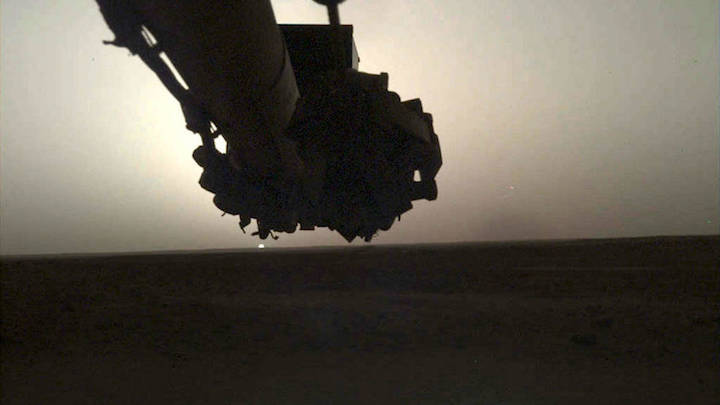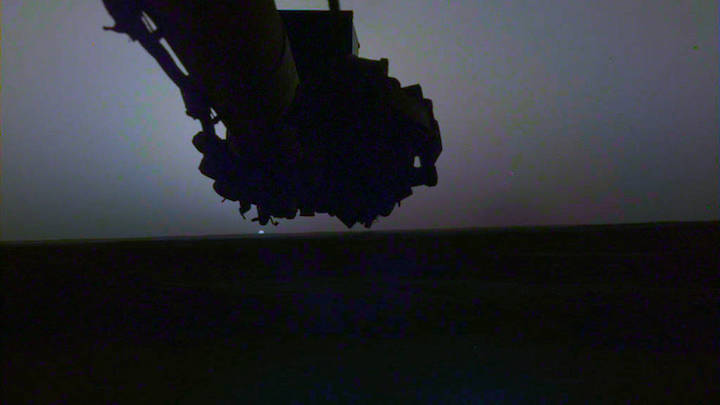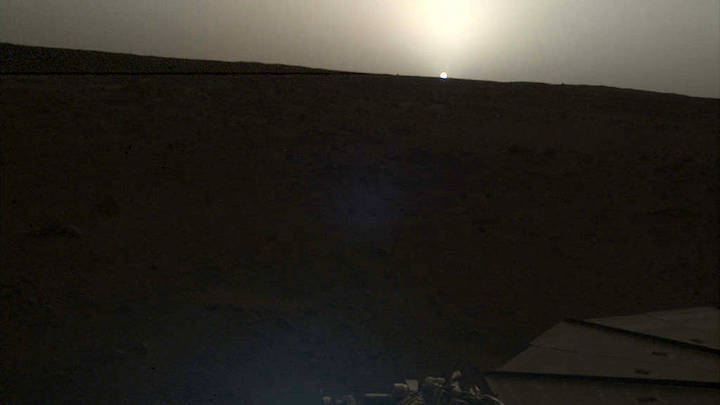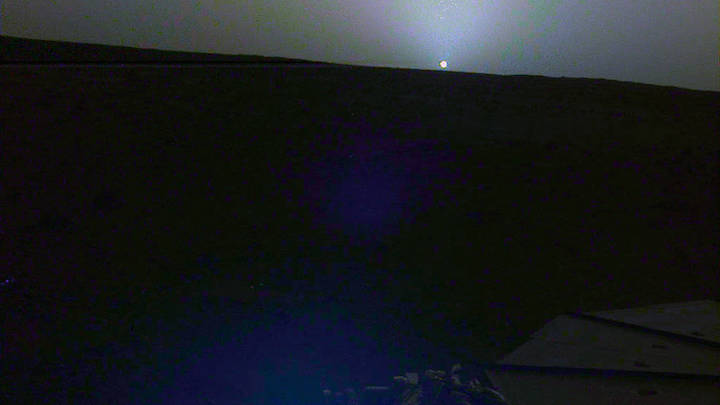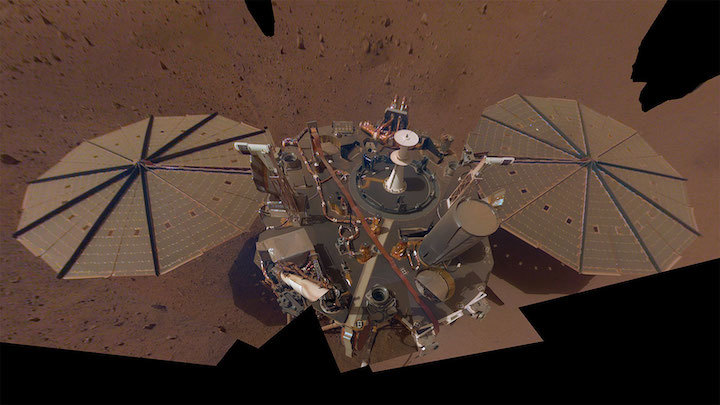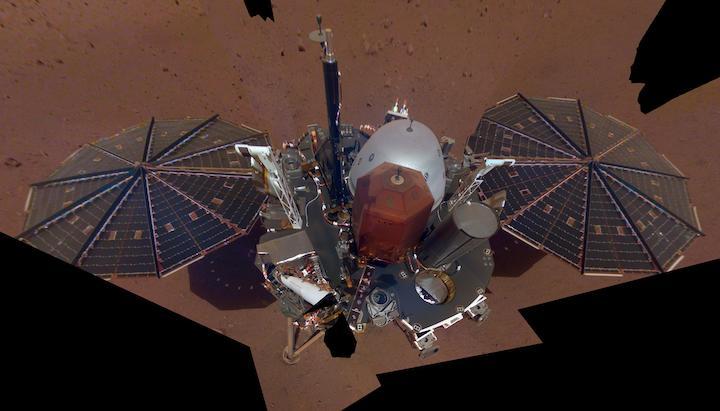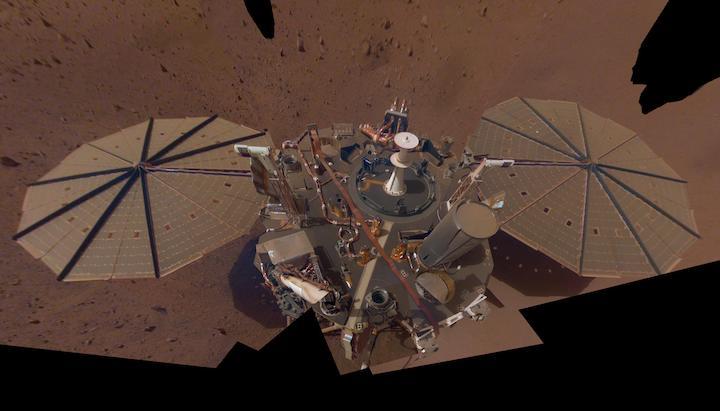11.03.2019
Das Logbuch zu InSight
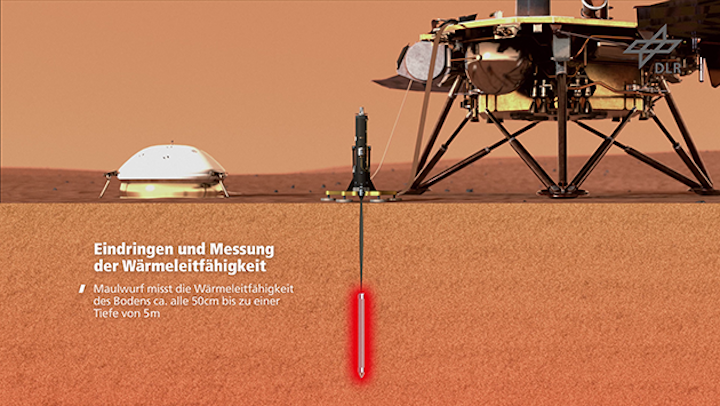
Der wissenschaftliche Leiter des HP3-Instruments, Tilman Spohn, ist vor Ort in Pasadena, USA, und versorgt uns im Logbuch mit den neuesten Entwicklungen der InSight Mission und unsers Instruments HP3, dem #MarsMaulwurf, der sich in den Marsboden hämmert.
Logbuch-Eintrag vom 6. März 2019
Ausgezeichnete Neuigkeiten! Wir haben gerade die Daten der ersten Phobos-Finsternis erhalten: Die Abkühlung durch den Schatten, der innerhalb von etwa 30 Sekunden durch das Sichtfeld des Radiometers ging, ist deutlich sichtbar. Die Temperatur ging um etwa 1 Grad Celsius zurück und ist damit größer als erwartet und zweifellos besser als bei den pessimistischsten Schätzungen (= wir werden es überhaupt nicht sehen können)! Das Team ist glücklich und freut sich über die erste Sonnenfinsternis auf dem Mars, die jemals mit einem Radiometer beobachtet wurde.
Was bedeutet das Ganze nun? Es gibt eine Größe, die Wissenschaftler die "thermische Trägheit" nennen. Sie ist abhängig von der Wärmeleitfähigkeit des oberflächennahen Materials, seiner Dichte und seiner Wärmekapazität. Ein kleiner Wert zeigt beispielsweise eine niedrige Wärmeleitfähigkeit oder eine große Porosität (also eine niedrige Dichte) usw. an. Je größer die thermische Trägheit, desto geringer ist der Effekt. Insbesondere wenn sich der Schatten schnell bewegt und die Trägheit groß ist, ist der Effekt gering. Der messbare Effekt ist umso ausgeprägter, je kleiner die Trägheit ist. Das Team wird nun die Daten analysieren und ein Modell der obersten Millimeter des Oberflächenmaterials entwickeln. Ein Teil unserer Untersuchungen bilden also die geophysikalischen Parameter des Mars.
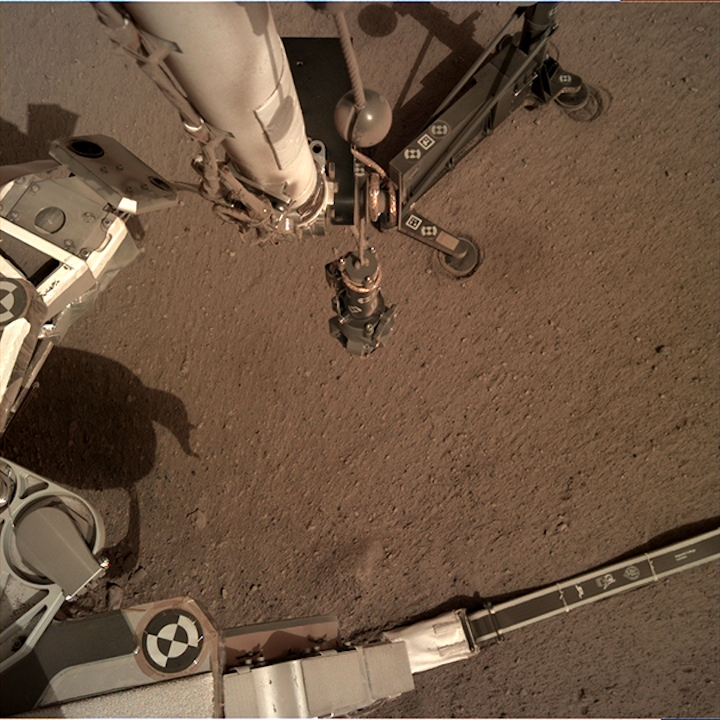
Was den Maulwurf betrifft, so wird das Team eine große Anzahl von Bildern erhalten, die von den Kameras auf dem InSight-Lander und dem Arm aufgenommen werden. Einige der Bilder, die wir bereits haben, zeigen, dass ein Teil des Maulwurfs tatsächlich sichtbar ist. Daraus schließen wir, dass der Maulwurf etwa 30 Zentimeter im Regolith und wahrscheinlich noch 7 Zentimeter im Rohr der Trägerstruktur steckt. Er zeigt etwa 15 Grad von der Vertikalen weg und hat entweder eine Drehung oder eine Veränderung seiner Drehachse erfahren.
Er ist immer noch gesund und munter, aber natürlich ist seine Lebensdauer begrenzt - in Bezug auf die Hammerschläge, die er durchführen kann, bevor er abgenutzt wird. Allerdings befürchten wir nicht, dass der Maulwurf so schnell kaputt geht. Dennoch will das Team auf Nummer sicher gehen und alle Informationen, die verfügbar sind, sammeln, einschließlich seismischer Daten, um zu sehen, wie wir dem Maulwurf helfen können, das Hindernis zu überwinden (oder durch eine mögliche Schotterschicht zu kommen). Sobald wir alle Daten haben, werden wir entscheiden, wie wir am besten vorgehen.
Dranbleiben!
Quelle: DLR
+++
Mission InSight: Pause für den Marsmaulwurf
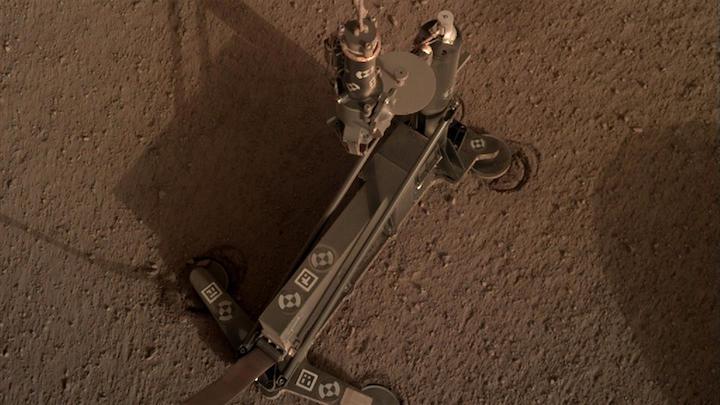
- Am 28. Februar begann der Marsmaulwurf in den Boden zu hämmern.
- Im Untergrund ist er möglicherweise auf einen Stein oder einen anderen starken Widerstand gestoßen.
- Die Forscher analysieren nun zunächst die Daten, bevor sie weiterhämmern werden.
- Schwerpunkte: Raumfahrt, Exploration
Das Deutsche Zentrum für Luft- und Raumfahrt (DLR) hat im Rahmen der NASA-Mission InSight eine Rammsonde entwickelt, um drei bis fünf Meter unter die Oberfläche des Mars zu graben und dort die Wärme aus dem Inneren des Roten Planeten zu messen. Nachdem der Marsmaulwurf am Donnerstag, den 28. Februar, damit begonnen hatte, sich in den Boden zu hämmern, kam die Sonde, die Teil des DLR-Instruments HP³ (Heat and Physical Properties Package) ist, etwa drei Viertel des Weges aus ihrer Gehäusestruktur heraus, bevor sie begann sich gegen einen starken Widerstand zu arbeiten. Dabei nahm sie eine leichte Neigung von 15 Grad ein.
"Das Team hat beschlossen, das Hämmern für etwa zwei Wochen auszusetzen, um die Situation genauer zu analysieren und gemeinsam Strategien zu entwickeln, wie sich der Widerstand überwinden lassen könnte", schreibt der Leiter des HP³-Experiments Prof. Tilman Spohn vom DLR-Institut für Planetenforschung in seinem Blog zur InSight-Mission . Die Forscher vermuten, dass der Maulwurf auf einen Stein oder eine Kiesschicht getroffen ist. Das Team hatte gehofft, dass es relativ wenige Steine unter der Erde geben würde, da Bilder der Landestelle nur wenige Brocken auf der Oberfläche neben dem Lander zeigen. Prinzipiell ist der Marsmaulwurf dafür entwickelt worden, kleinere Steine beiseite zu drücken und hat dies bei Tests vor dem Start zum Mars gezeigt.
Wärmeleitfähigkeitsmessungen beginnen
Alle empfangenen Daten zeigen, dass der Maulwurf selbst weiterhin wie erwartet funktioniert: Nach einer Aufheizphase während des Hämmerns mit einer Erwärmung um 28 Grad Celsius hat er beim Abkühlen gemessen, wie schnell die Wärme im Boden abgeführt wurde. Diese Eigenschaft, die als Wärmeleitfähigkeit bezeichnet wird, hilft bei der Bestimmung des Wärmeflusses aus dem tiefen Inneren des Planeten. Sobald der Maulwurf tief genug ist, kann der Wärmefluss genauer bestimmt werden.
In dieser Woche werden die Forscher weitere Messungen durchführen, um die Wärmeleitfähigkeit der oberen Schicht des Marsbodens (Regolith) genauer zu bestimmen. Zusätzlich wird das Radiometer auf der InSight-Landeplattform verwendet, um Temperaturänderungen des Bodens zu analysieren, die der Marsmond Phobos beim Vorbeizug vor der Sonne verursacht. Dreimal wird Phobos Schatten diese Woche wie bei einer Sonnenfinsternis auf der Erde durch das Gesichtsfeld des Radiometers ziehen, dass die Ereignisse vermisst.
Das HP³-Instrument auf der NASA-Mission InSight
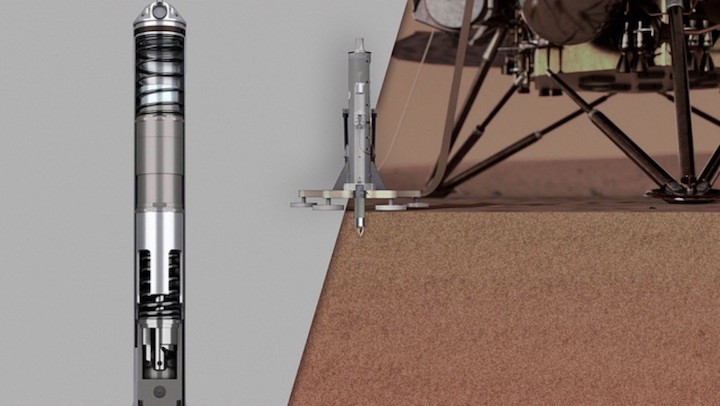
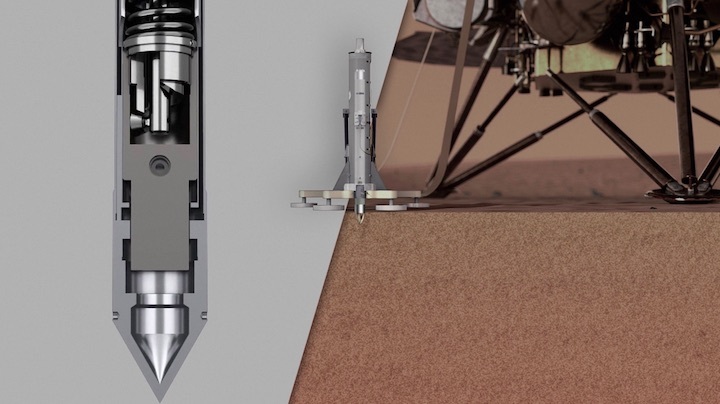
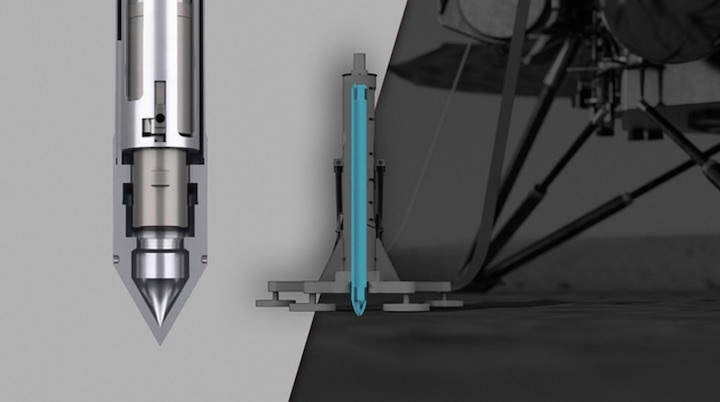
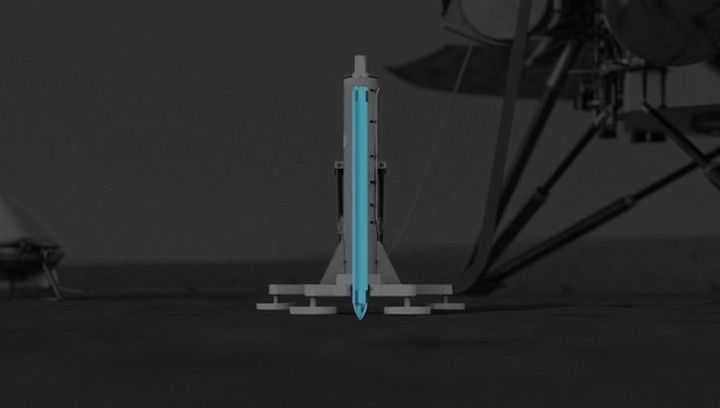
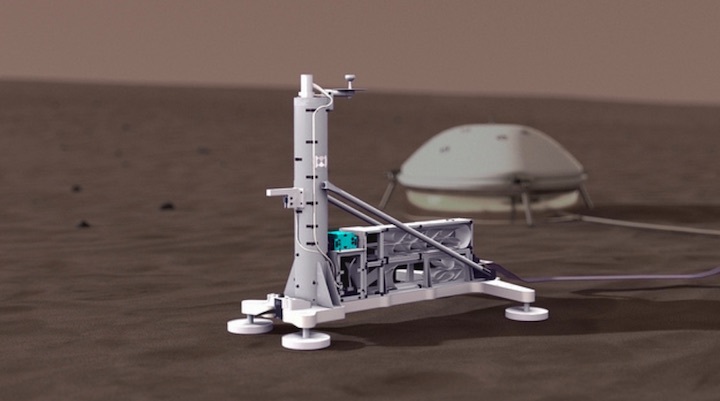
Die Mission InSight wird vom Jet Propulsion Laboratory (JPL) in Pasadena, Kalifornien, im Auftrag des Wissenschaftsdirektorats der NASA durchgeführt. InSight ist eine Mission des NASA-Discovery-Programms. Das DLR steuert zur Mission das Experiment HP³ (Heat Flow and Physical Properties Package) bei. Die wissenschaftliche Leitung liegt beim DLR-Institut für Planetenforschung, welches das Experiment federführend in Zusammenarbeit mit den DLR-Instituten für Raumfahrtsysteme, Optische Sensorsysteme, Raumflugbetrieb und Astronautentraining, Faserverbundleichtbau und Adaptronik, Systemdynamik und Regelungstechnik sowie Robotik und Mechatronik entwickelt und realisiert hat. Daneben sind beteiligte industrielle Partner: Astronika und CBK Space Research Centre, Magson und Sonaca, das Institut für Photonische Technologie (IPHT) sowie die Astro- und Feinwerktechnik Adlershof GmbH. Wissenschaftliche Partner sind das ÖAW Institut für Weltraumforschung und die Universität Kaiserslautern. Der Betrieb von HP³ erfolgt durch das Nutzerzentrum für Weltraumexperimente (MUSC) des DLR in Köln. Darüber hinaus hat das DLR Raumfahrtmanagement mit Mitteln des Bundesministeriums für Wirtschaft und Energie einen Beitrag des Max-Planck-Instituts für Sonnensystemforschung zum französischen Hauptinstrument SEIS (Seismic Experiment for Interior Structure) gefördert.
Quelle: DLR
----
Update: 19.03.2019
.
Seismic hum detected on Mars for the first time

NASA’s InSight lander places a protective, dome-shaped shield above its seismometer.
JPL-CALTECH/NASA
THE WOODLANDS, TEXAS—After months of delicate maneuvering, NASA’s InSight lander has finished placing its hypersensitive seismometer on the surface of Mars. The instrument is designed to solve mysteries about the planet’s interior by detecting the booming thunder of “marsquakes.” But just a few weeks into its run, the car-size lander has already heard something else: the minute tremors that continually rock our red neighbor. If marsquakes are the drum solo, these microseisms, as they’re known, are the bass line.
The signal first became apparent in early February, as soon as the lander placed a protective shield over the seismometer, said Philippe Lognonné, a planetary seismologist at Paris Diderot University who heads the team that runs the instrument, in a talk here today at the annual Lunar and Planetary Science Conference. “We do believe that these signals are waves coming from Mars.” This is the first time, he said, that such microseisms have been detected on another planet.
On Earth, microseisms are ubiquitous, caused largely by the sloshing of the ocean by storms and tides. Mars, despite the dreams of science fiction writers, has no present-day oceans. Instead, this newly discovered noise is likely caused by low-frequency pressure waves from atmospheric winds that rattle the surface, inducing shallow, longer-period waves in the surface, called Rayleigh waves, Lognonné said.
Even though InSight has not yet detected a marsquake, the microseisms are an important indicator that the lander’s seismometer is working as hoped. In recent decades, seismologists have begun to see microseisms on Earth as not just a nuisance, but as a valuable tool for understanding features in the subsurface. This noise will be similarly valuable on Mars, Lognonné said, allowing the team’s seismologists to probe the rigid surface crust in the immediate vicinity around the lander.
But the seismometer has had little time to listen so far. Although the sand-filled crater where InSight landed, nicknamed “Homestead Hollow,” had little in the way of large rocks to complicate its placement, the deployment still took a month longer than planned, thanks to two delicate tasks. First, scientists had to carefully tweak the electric tether connecting the seismometer to the lander, in order to reduce noise coming off the lander. Then, they had to place a wind and heat shield over the instrument.
Since then, InSight has spent much of its time troubleshooting for its second instrument, a heat probe designed to burrow up to 5 meters below the surface. The robotic arm placed that instrument in mid-February. But soon after the probe began to hammer itself into the surface, its 40-centimeter-long “mole” got stuck on a rock or some other blockage just 30 centimeters down. Now, mission scientists have put the hammering on hold as they wait for the agencies’ engineers to evaluate their options. That will continue for several more weeks, said Bruce Banerdt, InSight’s principal investigator and a geophysicist at NASA’s Jet Propulsion Laboratory in Pasadena, California.
Although the microseisms are a thrill to hear, everyone working on InSight is waiting for the main event: their first marsquake. There’s no need to panic about not seeing one yet, Banerdt said. “Before we get nervous … [the mission is] exactly where we expected to be.” The team expects to detect about one marsquake a month, but these will likely come in clusters, not perfectly spaced out. Banerdt, who had been preparing this mission for decades, can be patient, he said. “The wait’s not completely over yet.”
Quelle: Science
----
Update: 14.04.2019
.
More Testing for Mars InSight's 'Mole'
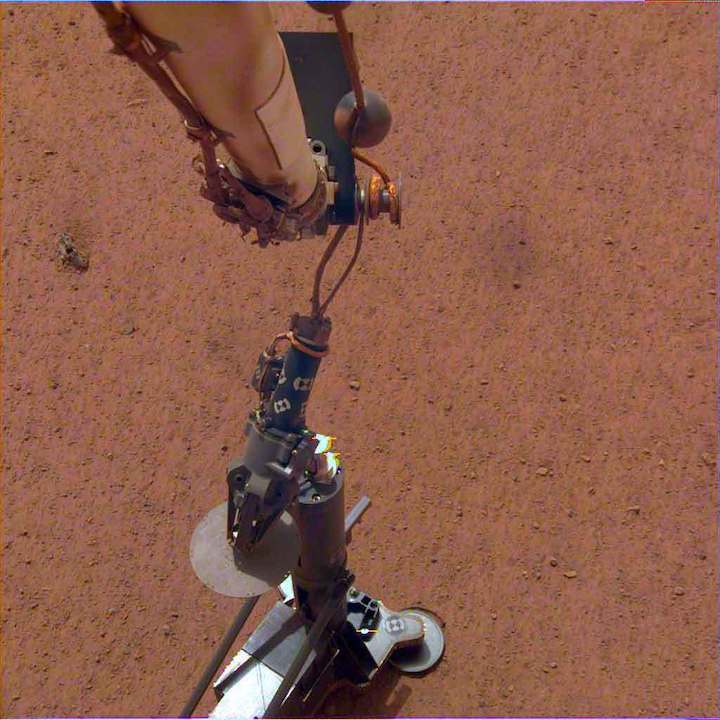
HP3 on the Martian Surface: NASA's InSight lander set its heat probe, called the Heat and Physical Properties Package (HP3), on the Martian surface on Feb. 12, 2019. Image Credit: NASA/JPL-Caltech/DLR. Full image and caption ›
Updated at 5 p.m. PDT (8 p.m. EDT) on April 11: InSight's Heat and Physical Properties Package (HP3) instrument completed a new round of diagnostic hammering into the Martian surface on March 26, 2019, while the spacecraft's seismometer listened in. The team working with the heat probe is continuing to analyze seismic data from this test. Based on the time between hammer strikes, scientists may be able to learn something new about what's obstructing the probe from digging farther underground.
This week, the German Aerospace Center (DLR) is busy wrapping up tests at a facility in Bremen, Germany, to better understand the properties of Martian soil. There are many questions about how the soil around InSight compacts or shifts during hammering. In addition to investigating whether the probe has struck a rock or a layer of gravel, scientists are exploring whether this sand isn't providing enough friction for the probe, also known as "the mole," to dig down. Find more information about DLR's recent testing here.
Even more testing is due to happen on Earth in coming weeks, after a replica of the HP3 instrument, which has been shipped to NASA's Jet Propulsion Laboratory in Pasadena, California, arrives and is set up. Engineers will use it to further analyze how InSight's robotic arm might be used to lift or move the mole's support structure as it digs.
Updated at 8 a.m. PDT (11 a.m. EDT) on March 21: More imaging and testing are planned to further study InSight's heat probe, formally known as the Heat and Physical Properties Package (HP3). That testing includes a new round of hammering, which was last attempted March 2. Many ideas for freeing up the mole are being considered, all of which will require at least several more weeks of careful analysis.
There is still little clarity as to whether the "mole" — the nickname for the self-hammering spike that is part of HP3 — is being blocked by a single rock or a layer of gravel. There is also the possibility that the probe or its cable might be stuck on something inside the instrument's protective housing.
Scientists had hoped to get the probe into the ground within a few months of InSight's landing. But so long as it eventually digs at least 10 feet (3 meters) underground, they can get useful science about the Martian interior regardless of when that happens.
Later this month, the team plans to conduct a 10-to-15-minute hammering test. That will allow InSight's seismometer to "listen" to the mole striking whatever obstacle it has hit, offering possible clues as to what may be blocking it. Meanwhile, the camera on InSight's robotic arm will photograph the mole's support structure in the hopes of catching any possible motion induced by the mole during hammering.
In April, a replica of HP3 will be shipped to NASA's Jet Propulsion Laboratory in Pasadena, California. That will allow JPL's team to begin testing in concert with German Aerospace Center (DLR) engineers working with similar models in Bremen, Germany.
Quelle: NASA
----
Update: 24.04.2019
.
NASA’s InSight Lander Captures Audio of First Likely ‘Quake’ on Mars

NASA’s Mars InSight lander has measured and recorded for the first time ever a likely “marsquake.”
The faint seismic signal, detected by the lander’s Seismic Experiment for Interior Structure (SEIS) instrument, was recorded on April 6, the lander’s 128th Martian day, or sol. This is the first recorded trembling that appears to have come from inside the planet, as opposed to being caused by forces above the surface, such as wind. Scientists still are examining the data to determine the exact cause of the signal.
“InSight’s first readings carry on the science that began with NASA’s Apollo missions,” said InSight Principal Investigator Bruce Banerdt of NASA’s Jet Propulsion Laboratory (JPL) in Pasadena, California. “We’ve been collecting background noise up until now, but this first event officially kicks off a new field: Martian seismology!”
The new seismic event was too small to provide solid data on the Martian interior, which is one of InSight’s main objectives. The Martian surface is extremely quiet, allowing SEIS, InSight’s specially designed seismometer, to pick up faint rumbles. In contrast, Earth’s surface is quivering constantly from seismic noise created by oceans and weather. An event of this size in Southern California would be lost among dozens of tiny crackles that occur every day.
“The Martian Sol 128 event is exciting because its size and longer duration fit the profile of moonquakes detected on the lunar surface during the Apollo missions,” said Lori Glaze, Planetary Science Division director at NASA Headquarters.
NASA’s Apollo astronauts installed five seismometers that measured thousands of quakes while operating on the Moon between 1969 and 1977, revealing seismic activity on the Moon. Different materials can change the speed of seismic waves or reflect them, allowing scientists to use these waves to learn about the interior of the Moon and model its formation. NASA currently is planning to return astronauts to the Moon by 2024, laying the foundation that will eventually enable human exploration of Mars.
InSight’s seismometer, which the lander placed on the planet’s surface on Dec. 19, 2018, will enable scientists to gather similar data about Mars. By studying the deep interior of Mars, they hope to learn how other rocky worlds, including Earth and the Moon, formed.
Three other seismic signals occurred on March 14 (Sol 105), April 10 (Sol 132) and April 11 (Sol 133). Detected by SEIS’ more sensitive Very Broad Band sensors, these signals were even smaller than the Sol 128 event and more ambiguous in origin. The team will continue to study these events to try to determine their cause.
Regardless of its cause, the Sol 128 signal is an exciting milestone for the team.
“We’ve been waiting months for a signal like this,” said Philippe Lognonné, SEIS team lead at the Institut de Physique du Globe de Paris (IPGP) in France. “It's so exciting to finally have proof that Mars is still seismically active. We're looking forward to sharing detailed results once we've had a chance to analyze them.”
Most people are familiar with quakes on Earth, which occur on faults created by the motion of tectonic plates. Mars and the Moon do not have tectonic plates, but they still experience quakes – in their cases, caused by a continual process of cooling and contraction that creates stress. This stress builds over time, until it is strong enough to break the crust, causing a quake.
Detecting these tiny quakes required a huge feat of engineering. On Earth, high-quality seismometers often are sealed in underground vaults to isolate them from changes in temperature and weather. InSight’s instrument has several ingenious insulating barriers, including a cover built by JPL called the Wind and Thermal Shield, to protect it from the planet's extreme temperature changes and high winds.
SEIS has surpassed the team’s expectations in terms of its sensitivity. The instrument was provided for InSight by the French space agency, Centre National d’Études Spatiales (CNES), while these first seismic events were identified by InSight's Marsquake Service team, led by the Swiss Federal Institute of Technology.
“We are delighted about this first achievement and are eager to make many similar measurements with SEIS in the years to come,” said Charles Yana, SEIS mission operations manager at CNES.
JPL manages InSight for NASA’s Science Mission Directorate. InSight is part of NASA’s Discovery Program, managed by the agency’s Marshall Space Flight Center in Huntsville, Alabama. Lockheed Martin Space in Denver built the InSight spacecraft, including its cruise stage and lander, and supports spacecraft operations for the mission.
A number of European partners, including CNES and the German Aerospace Center (DLR), support the InSight mission. CNES provided the SEIS instrument to NASA, with the principal investigator at IPGP. Significant contributions for SEIS came from IPGP; the Max Planck Institute for Solar System Research in Germany; the Swiss Federal Institute of Technology (ETH Zurich) in Switzerland; Imperial College London and Oxford University in the United Kingdom; and JPL. DLR provided the Heat Flow and Physical Properties Package (HP3) instrument, with significant contributions from the Space Research Center of the Polish Academy of Sciences and Astronika in Poland. Spain’s Centro de Astrobiología supplied the temperature and wind sensors.
Quelle: NASA
----
Update: 2.05.2019
.

